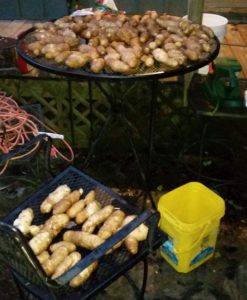Some of the links below are affiliate links, meaning, at no additional cost to you, I will earn a commission if you click through and make a purchase.
Having recovered (mostly) from Pennsic (the gallery is in the sidebar on the right), we found it was time to get stuck in on the garden and related outside-the-house things. In particular, it was time to do the summer harvest, before the weeds made it completely impossible. Also on the agenda: starting to reclaim the flower beds, and getting the garden beds ready for fall plantings.
Weedmageddon and a Harvest
It seems that we encounter some version of “weedmageddon” every year–a bout of summer rains, alternating with intense heat, often with crazy work schedules, and we can’t keep up with the weeds in the garden, much less get a decent harvest in. This year, the culprit was Pennsic, combined with frequent rains.
On our return, the garden had jumped from barely knee-high plants and a pretty controlled weed situation, to plants (mostly weeds) up to eye-level. An emergency “pull all the weeds!” session was held, combined with brutal prunings of the tomato plants which had threatened to crawl across the entire garden. We salvaged what tomatoes we could, but the chickens were gifted with more than a few of them.
 Once things were more or less under control, we set about harvesting what we could. The onions did pretty well, particularly the yellow ones–the red onions never got much above golf-ball sized. The garlic ended up being pretty much a non-starter; we’ll get some more in for the fall, when they’ll be happier with the cool weather. But the big success was the potatoes. From a few small hills, we actually got about 50 pounds! (A photo of the harvest is to the right–please excuse the [ahem] potato-quality picture…)
Once things were more or less under control, we set about harvesting what we could. The onions did pretty well, particularly the yellow ones–the red onions never got much above golf-ball sized. The garlic ended up being pretty much a non-starter; we’ll get some more in for the fall, when they’ll be happier with the cool weather. But the big success was the potatoes. From a few small hills, we actually got about 50 pounds! (A photo of the harvest is to the right–please excuse the [ahem] potato-quality picture…)
The tomato harvest is still ongoing, of course, and the pole beans have only just really kicked into gear. Most of the squash have croaked, but a couple of pumpkin vines are still fighting on–the best one being the “volunteer” in the front flower bed. We’ll see how they do.
Getting Things Ready for Fall
The plan for the fall garden includes lots of brassicas–cabbage, bok choi, brussels sprouts, cauliflower, broccoli, and the like. Other beds will get root vegetables, such as beets, turnips, and radishes. Additionally, we’ve got a few unusual things to try out: salsify (two varieties), sugar beets, and swedes (related to rutabagas), to name a few.
A couple of the beds are going to lay fallow over the winter, and I hope to talk my wife into letting me put some winter grains in some of them. A few varieties, I’ve only got enough for about a two-foot square plot; with the winter wheat, I can probably do a full bed. The greens (after I clip the grains, in the spring) would be a good green manure, and having the plants in the garden would cut back on deer predation, which means I might get to harvest some of them, and grow up a better volume of grains.
Other fall preps include keeping a weather eye on the bees. They’ve been sucking down the sugar-water, almost as fast as I can put it out (about a quart each day and a half, give or take). They’ve been slow to draw out supers–I’m giving them another couple of weeks to work on them–but they’re doing fine as far as brood and pollen; their mite counts are as low as expected (zero–these are ‘hygienic’ Russian bees), and they look healthy. At this point I’m cautiously optimistic, but I’ve been here before. Another hive inspection in early- to mid-September will, I think, tell me how things are going to go.
Brewing, Of Course
The August brew day was one of cellar management. I racked some meads over to secondary, and cleaned a couple of things up in the cellar. Upcoming brew days will likely include some teaching moments (several folks have asked me to teach them about brewing), as well as some possible equipment upgrades, and playing around with some interesting techniques. In particular, I’m hoping to:
- Upgrade fermenters. I haven’t decided whether to go with conicals, BrewBuckets (almost-conicals), or 10-gallon corny kegs. Pricing, availability, and funds will end up deciding.
- Get an “official” water analysis done on the well water, with the goal of being able to dial things in a bit tighter.
- Do more in the way of session beers–I have my eyes set primarily on English milds and bitters, although as things cool off, I’m thinking about making a Kolsch or two, as well.
- Do a parti-gyle, in the style of Fuller’s (two sets of wort run off from the grains, then mixing the end results). It would require a little juggling of equipment, but I think the results would be fun.
- Get another 20-gallon Igloo cooler, with the intent of being able to do some really big mashes–possibly even enough for a 5-gallon batch of Braunschweiger Schiff-Mumme.
Please stick around, sign up for the mailing list (to be alerted to new posts), and feel free to comment below!
